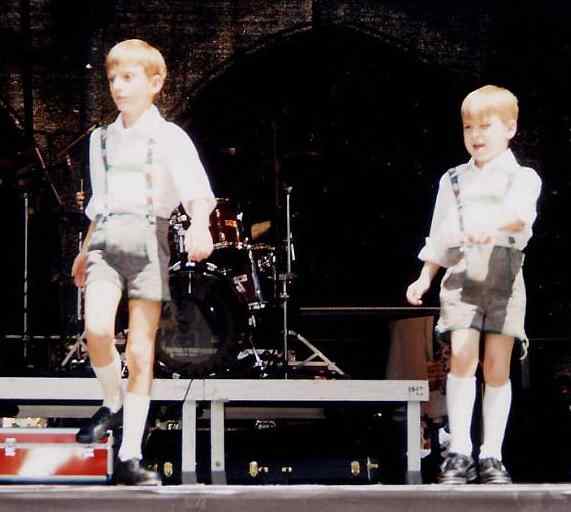
Ethnic or Folk Dancing Costumes: German Dance

Figure 1.--These boys are doing German folkdancing at some kind of folk or dance festival. The boys are clearly doing a German dance, but this may be an American festival. Note that the halters that the boys ar wearing with their lederhosen do not look authentic.
|
Everyone is familiar with German polka and ump-pa-pah bands and associated dancing. The dancers normally perform in costume--usually lederhosen outfits. Unfortunately HBC has very little information about German folk dancing. We are not sure about the style of dancing involved. Hopefuly our German readers will provide us some information about national folk dancing. Generally the participants are Germans or ethnic Germans in other counries. It is of course a popular activity at October Fest celebrations. German groups generally have traditional costumes. Groups in other countries, especially where children participate, often have improvised costumes. We know that there was a revival in all aspects of folk culture, including songs and dance, in Germany during the late 19th and eraly 20th century. The Wandervogel , the first German youth group, in particular was noted for this.
Costuming
A European readr writes, "I do agree that their halters don't look authentic either, especially the crossbars. Also they seem to be wearing a simple kind of lederhosen made of cheap "Spaltleder" which Bavarians rather depreciatingly call "Sepplhose". They associate it with Northern Germany, which had no lederhosen tradition until early in the 20th century, and as this is the type which is commercially available in the U.S., it may indeed be an American group. Third: I think that most Alpine groups would wear "loferl" i.e. that
special kind of hosiery which covers the calves and leaves the ankles free. (I am not sure though that this holds true for all present day groups, esp. for children, outside the Bavarian heartland)."
There are several different German folk dances. South Germany (especially Swabia and Bavaria) is best known for folk dancing. The German folk dances are quite varied and numerous.
Bandltanz: This is danced around a may pole.
Bärbele: Turning around in circles, going for and backwards with bowing but not facing each other, women turning around men following her.
Fingerlestanz: Dancers turn in circles, stand still, stumping with feet and “scolding” , then again turning around.
Landler:
Patscher: handclapping, turning around in circles.
Polkas:
Rheinländer: Bayerisch Polka.
Rutscher: The dance includes back and forward stepping, turning around in circles.
Schlittschuhläufer: The dance in pairs form left to right also in circles like skating on ice.
Schäferlaufmarsch: Known in Markgrönningen and Bad Urach, where the Schäferlauf is still held. Shepherds have to show that their sheep can behave. There’s also a competition between young women who have to run over a mowed field bare feet. The fastest gets a prize.
Schuhplattler: Of course this is the the most famous one. There are many Schuhplattler groups in America and usually at least one in countries with German immigrants.n We have noted an English school which established a Schuplattlergruppe as part of the German language program. It has also been said that the Schuhplattler originally was danced by young men to court their lovers, later it became more a dance for tourists.
Siebensprung: For children running around in a circle, turning around, stamping feet, standing on one foot, knee-fall, laying on
earth like a rabbit, etc). A German reader writes, "This is famous because of the Dutch childrens book of the same title: Das Geheimnis des Siebensprungs (Het sevensprong) of Tonke Dragt, about a school teacher, who tells scary and exciting stories to his class, is involved in one, too: He has to help a 10 year old boy in a castle and find together with his class a treasure. The name applies to a crossroad of seven ways, as well as to the folk dance. It was filmed in the 1980s as well. I enjoyed watching it back then."
Waltzes:
Figure Dancing
Figures include: pair building, turning around in circles, holding hands crossed and going to and fro also jumping in the same way, hand clapping.
We know that there was a revival in all aspects of folk culture, including songs and dance, in Germany during the late 19th and eraly 20th century. The Wandervogel , the first German youth group, in particular was noted for this. The Hitler Youth in the 1930s adopted many features of Wandervogel, but an interest in folk dance was not one of them.
HBC

Navigate the Historic Boys' Clothing Web Site:
[Return to the Main ethnic dance page]
[Return to the Main German activities page]
[Introduction]
[Activities]
[Biographies]
[Chronologies]
[Style Index]
[Countries]
[Bibliographies]
[Contributions]
[FAQs]
[Glossaries]
[Satellite sites]
[Tools]
[Boys' Clothing Home]
Navigate the Historic Boys' Clothing Web chronological pages:
[The 1900s]
[The 1910s]
[The 1920s]
[The 1930s]
[Thw 1940s]
[The 1950s]
[The 1960s]
[The 1970s]
[The 1980s]
[The 1990s]
Navigate the Historic Boys' Clothing Web style pages:
[Kilts]
[Caps]
[Sailor hats]
[Lederhosen]
[Sailor hats]
Created: August 2, 2003
Last updated: September 14, 2003



